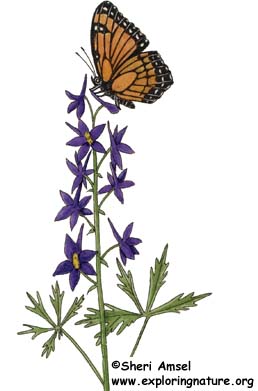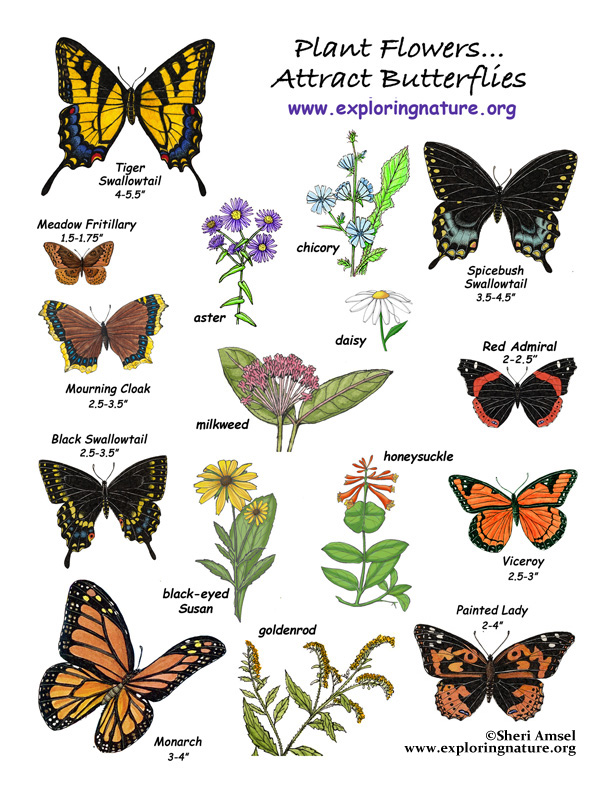

Butterflies feed on the flower nectar of certain plants. You can plant these plants in your garden and attract a lot of visiting butterflies. You might also plant some plants that the butterflies' caterpillars like to eat. The butterflies will then lay their eggs on those plants and their caterpillars will hatch out and they will feed on your flowers. They are rather interesting to look at themselves. Then they will pupate and hatch out into more butterflies!
What To Plant
1) Different species of butterflies will be attracted to different plants according to their taste in nectar or even flower color. If you want to attract a variety of butterflies, plant a variety of flowers.
2) Also try to plant things that will bloom all summer long so your butterflies will have food all season. You can do this by planting some early bloomers and some later bloomers. That way there will always be something blooming in your butterfly garden.
3) Butterflies are attracted to groups of flowers, so be sure and plant more than one flower in any area.
4) They also like puddles of water. Collections of male butterflies at a puddle is called a “puddle club.” In a butterfly garden you can have a bowl sunk into the ground and filled with water or even fruit juice. This will attract butterfly to congregate. Some people use stale beer, but this can also attract slugs and snails.
5) Some examples of flowers that butterflies like are cosmos, Queen Anne’s lace, zinnia, butterfly weed, coneflowers, New England asters, spearmint, milkweed, yarrow, phlox, ironweed, thistles, verbena, goldenrod, Shasta daisy, coreopsis, black-eyed Susan, yarrow, sedum, sunflowers, and daylilies. These will also make beautiful gardens!
6) Here are some specific flowers that butterflies and their caterpillars like to eat.
Butterfly Adult Favorite Foods
Swallowtail Adult: the nectar of milkweed, goldenrod, lilac, azalea, honeysuckle, verbena
Swallowtail Caterpillar: the leaves of orange trees, ash trees
Fritillary Adult: the nectar of milkweed, ironweed, mint, goldenrod, thistles, butterfly bush
Fritillary Caterpillar: violets
Monarch Adult: the nectar of milkweed, ironweed, black-eyed Susan, verbena
Monarch Caterpillar: milkweed
Mourning Cloak Adult: the nectar of milkweed, butterfly bush, daisies, fallen fruit from fruit trees rotting on the ground
Mourning Cloak Caterpillar: the leaves of aspen, birch, elm, willow and poplar
Painted Lady Adult: the nectar of milkweed, goldenrod, zinnia, butterfly bush, asters
Painted Lady Caterpillar: daisies and hollyhocks
Red Admiral Adult: the nectar of milkweed, goldenrod, butterfly bush, asters, daisies, fallen fruit from fruit trees rotting on the ground
Red Admiral Caterpillar: the leaves of nettles
Tiger Swallowtail Adult: the nectar of milkweed, butterfly bush, ironweed, honeysuckle, phlox, lilac blossoms
Tiger Swallowtail Caterpillar: the leaves of lilac bushes, cherry, ash, birch, and tulip tree
Viceroy Adult: the nectar of milkweed, goldenrod and asters, fallen fruit from fruit trees rotting on the ground
Viceroy Caterpillar: the leaves of apple, willow and poplar trees
When you research information you must cite the reference. Citing for websites is different from citing from books, magazines and periodicals. The style of citing shown here is from the MLA Style Citations (Modern Language Association).
When citing a WEBSITE the general format is as follows.
Author Last Name, First Name(s). "Title: Subtitle of Part of Web Page, if appropriate." Title: Subtitle: Section of Page if appropriate. Sponsoring/Publishing Agency, If Given. Additional significant descriptive information. Date of Electronic Publication or other Date, such as Last Updated. Day Month Year of access < URL >.
Amsel, Sheri. "Plant a Butterfly Garden" Exploring Nature Educational Resource ©2005-2024. December 13, 2024
< http://www.exploringnature.org/db/view/1181 >

